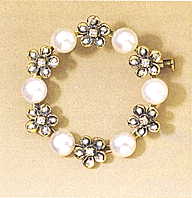  |

|

Fig.1. "Paeonia Byzantina"
from the "Golden Peonies" collection, necklace in 18
carat gold.
MARAMENOS& PATERAS JEWELLERS.
|

Fig. 2. "Ear of Wheat", brooch in
22 carat gold. Copy of a 3rd century BC find from near Syracuse.
CHRISTOTECHNIKI S. TOMAZINAKIS & SONS
|
|


Fig. 3&4. Classic
traditional pieces, mainly handmade in 18 carat gold and set with
diamonds and pearls.
NIK. G. KANDARAKIS
|
|

Fig. 5. Handmade brooch, in 18
carat gold, with handcarved onyx cameo of pegasus embellished with
tiny diaminds.
|

Fig. 6. Byzantine
style cross, symbol of religion, symbol of power. 18 carat gold set
with rubies, emeralds and pearls
LAVORO, MARIA N. POULKOURA-VOUTIRA
|
Athens quickly grew into a major metropolis where craftsmen gathered from all
over Greece. The constant need for ecclesiastical vessels kept alive the
traditional minor art of silver- and goldsmithing, while the observance of
certain mores and customs, such as presenting a gold cross at the christening,
the exchange of jewellery on betrothal, sustained many silver- and goldsmithing
workshops throughout Greece, where objects were wrought in age-old techniques.
In Crete for example, it is customary for the prospective groom to present his
bride-to-be with a necklace with `boutonia' at the engage- ment ceremony. The
design and technique of the filigree decoration on the delicate gold `boutonia'
-beads hark back to Minoan times.
There is no doubt that the purchasing pub- lic's preference for European
jewellery led to a lull in some of the traditional techniques. However, many
were still applied in the minor arts, as well in isolated workshops in old
silver- and goldsmithing centres such as Ioannina, Corfu, Rhodes, Macedonia and
Stemnitsa in the Peloponnese. The supply of raw materials during the nineteenth
and the early twentieth century was almost exclusively from Constantinople
(Istanbul), which continued to be one of the most famous silver- and
goldsmithing centers. In parallel it was a usual phenomenon for workshops to
melt down old jewellery to make new pieces, according to the customer's wishes.
This meant that many notable old ornaments were irrevocably lost.
From about 1930 onwards the new craftsmen working in the Athenian goldsmithing
workshops created beautiful handmade jewellery in the European style using
traditional techniques. So even though craftsmen had ceased producing
traditional jewellery as such they were proficient in the techniques.This fact,
combined with their experience and talent, enabled them to meet the new demand
for Greek jewellery particularly copies of ancient Greek ornaments, mainly from
tourists, that began in the 1950s. In response to the needs of this new market
Greek jewellers not only applied traditional techniques but also renewed them by
exploiting the achievements of modern technology as well.
Despite the prevailing adoration of everything European during this first.
period, counter forces emerged, mainly from enlightened intellectuals who, in
their endeavor lo arouse the bourgeoisie from the lethargy of imitation into
which it had fallen, delved ever deeper into those elements composing the
enduring unity and cohesion of the Greek spirit. We cite indicatively General
Makryyannis and his `Memoirs', the painter and 1821 freedom-fighter Vryzakis,
the poet Angelos Sikelianos, the writer Pantelis Yannopoulos, the painters
Parthenis and Kontoglou, as well as many other important personalities who
sought out the essence of Hellenism and the components of its creative course
and continuity. Their efforts bore fruit. later, constituting the substratum of
the modern cultural floruit. and the revival of interest in the values of recent
Greek civilization. Jewellery was included in the creative course of Greek art
that. soon developed, evoking wider interest at home and abroad.
|
|


|
Greece jewellery pages Copyright ©
by Add
Information Systems. (Greece)
|
|
  |

